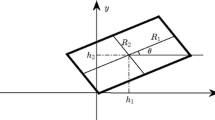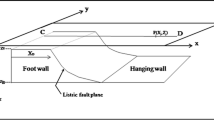Abstract
An automatic inversion technique is presented to analyse the magnetic anomalies produced by 2D fault sources having nonplanar fault planes. This technique provides a means to analyse the magnetic anomalies of the structure measured in any component (i.e., vertical, horizontal or total). The present technique uses the polynomial functions to describe the fault plane, the coefficients of which become the unknown parameters to be estimated from the magnetic anomalies along with the other shape parameters, namely, the depths to the top and bottom of the fault structure, the location of the fault edge, besides intensity and direction of magnetisation. This technique initialises the model space based on some characteristic anomalies and their positions on the anomaly profile and subsequently updates them iteratively following the predefined convergence conditions. The closeness of fit between the recovered and assumed theoretical models of a fault structure from the analysis of noise-added vertical magnetic anomalies justifies the strength and applicability of the proposed technique. The observed total magnetic anomalies along an EW profile across the western margin of the Perth Basin, Australia are interpreted and the results are compared with the available/reported information.





Similar content being viewed by others
References
Abdelrahman E M and Essa K S 2015 Three least-squares minimisation approaches to interpret gravity data due to dipping faults; Pure Appl. Geophys. 172 427–438.
Abdelrahman E M, El-Araby H M, El-Araby T M and Abo-Ezz E R 2003 A least-squares derivatives analysis of gravity anomalies due to faulted thin slabs; Geophysics 68 535–543.
Al-Garni M A 2016 Artificial neural network inversion of magnetic anomalies caused by 2D fault structures; Arab. J. Geosci. 9, 156, https://doi.org/10.1007/s12517-015-2256-y.
Anderson N L, Essa K S and Elhussein M 2020 A comparison study using particle swarm optimisation inversion algorithm for gravity anomaly interpretation due to a 2D vertical fault structure; J. Appl. Geophys. 179, 104120, https://doi.org/10.1016/j.jappgeo.2020.104120.
Biswas A and Rao K 2021 Interpretation of magnetic anomalies over 2D fault and sheet-type mineralised structures using very fast simulated annealing global optimisation: An understanding of uncertainty and geological implications; Lithosphere 2964057, https://doi.org/10.2113/2021/2964057.
Chakravarthi V 2003 Digitally implemented method for automatic optimisation of gravity fields obtained from three-dimensional density interfaces using depth dependent density – US Patent # 6,615,139.
Chakravarthi V 2010a Gravity anomalies of 2D fault structures with fault planes described by polynomial functions of arbitrary degree; Curr. Sci. 99 654–656.
Chakravarthi V 2010b Gravity anomalies of strike limited listric fault sources with analytically defined fault planes and arbitrary density contrast variations with depth; Near Surf. Geophys. 8 279–286.
Chakravarthi V 2011 Automatic gravity optimisation of 2.5D strike listric fault sources with analytically defined fault planes and depth dependent density; Geophysics 76 I21–I31.
Chakravarthi V and Pramod Kumar M 2015 Estimation of multiple density-depth parameters from gravity inversion: Application to detached hanging wall systems of strike limited listric fault morphologies; Geofis. Int. 54 49–65.
Chakravarthi V and Sundararajan N 2004 Ridge regression algorithm for gravity inversion of fault structures with variable density; Geophysics 69 1394–1404.
Chakravarthi V, Singh S B and Ashok Babu G 2001 INVER2DBASE – A program to compute basement depths of density interfaces above which the density contrast varies with depth; Comput. Geosci. 27 1127–1133.
Chakravarthi V, Pramod Kumar M, Ramamma B and Rajeswara Sastry S 2017 Gravity anomaly interpretation of 2D fault morphologies by means of nonplanar fault planes and exponential density contrast model: A space domain technique; Arab. J. Geosci. 10 64, https://doi.org/10.1007/s12517-017-2845-z.
Ekinci Y L, Balkaya C and Göktürkler G 2019 Parameter estimations from gravity and magnetic anomalies due to deep-seated faults: Differential evolution versus particle swarm optimisation; Turkish J. Earth Sci. 28 860–881.
Elhussein M 2021 New inversion approach for interpreting gravity data caused by dipping faults; Earth Space Sci. 8 e2020EA001075, https://doi.org/10.1029/2020EA001075.
Essa K S 2013 Gravity interpretation of dipping faults using the variance analysis method; J. Geophys. Eng. 10 015003, https://doi.org/10.1088/1742-2132/10/1/015003.
Essa K S 2021 Evaluation of the parameters of the fault-like geologic structure from the gravity anomalies applying the particle swarm; Environ. Earth Sci. 80, https://doi.org/10.1007/s12665-021-09786-1.
Essa K S and Elhussein M 2018 PSO (Particle Swarm Optimization) for interpretation of magnetic anomalies caused by simple geometrical structures; Pure Appl. Geophys. 175 3539–3553.
Essa K S, Géraud Y and Diraison M 2021 Fault parameters assessment from the gravity data profiles applying the global particle swarm optimisation; J. Petrol. Sci. Eng. 207, 109129, https://doi.org/10.1016/j.petrol.2021.109129.
Green R 1979 The harmonic method of inverting a magnetic profile over a contact; Geoexploration 17 261–268.
Jackson J A 1987 Active normal faulting and crustal extension; Geol. Soc. London, Spec. Publ. 28 3–17.
Koulomzine T, Lamontamte Y and Nadeau A 1970 New methods for the direct interpretation of magnetic anomalies caused by inclined dikes of infinite length; Geophysics 35 812–830.
Kovac P, Cevallos C and Feijth J 2016 Targeting oil and gas in the Perth Basin using an airborne gravity gradiometer; First Break 34 51–58.
Marquardt D W 1970 Generalised inverses, ridge regression, biased linear estimation, and nonlinear estimation; Technometrics 12 591–612.
Middleton M F, Wilde S, Evans B A, Long A and Dentith M 1993 Preliminary interpretation of deep seismic reflection and other geophysical data from the Darling Fault Zone, Western Australia; Explor. Geophys. 24 711–718.
Murthy I V R 1985 The mid-point method: Magnetic interpretation of dykes and faults; Geophysics 50 834–839.
Murthy I V R 1998 Gravity and magnetic interpretation in exploration geophysics; Geol. Soc. India Memoir 40.
Murthy I V R, Rao C V and Krishna G G 1980 A gradient method for interpreting magnetic anomalies due to horizontal circular cylinders, infinite dykes and vertical steps; Proc. Indian Acad. Sci. (Earth Planet. Sci.) 89 31–42.
Murthy I V R, Swamy K V and Rao S J 2001 Automatic inversion of magnetic anomalies of faults; Comput. Geosci. 27 315–325.
Nibisha V A, Ramamma B, Sastry R S and Chakravarthi V 2021 Forward modelling: Magnetic anomalies of arbitrarily magnetised 2D fault sources with analytically defined fault planes; J. Earth Syst. Sci. 130 130, https://doi.org/10.1007/s12040-021-01634-x.
Powell D W 1967 Fitting observed profiles to a magnetised dyke or fault-step model; Geophys. Prospect. 15 208–220.
Qureshi I R and Nalaye A M 1978 A method for the direct interpretation of magnetic anomalies caused by two-dimensional vertical faults; Geophysics 43 179–188.
Raju D, Ch V, Ravikumar S and Mishra D C 1998 Inversion of gravity anomaly due to a contact (fault) and its application for graben tectonics across Godavari basin; Curr. Sci. 75 1184–1188.
Ramamma B, Mallesh K and Chakravarthi V 2021 3D Spatial domain gravity inversion with growing multiple polygonal cross-sections and exponential mass density contrast; J. Earth Syst. Sci. 130 73, https://doi.org/10.1007/s12040-021-01576-4.
Rao D B 1985 Analysis of gravity anomalies over an inclined fault with quadratic density function; Pure Appl. Geophys. 123 250–260.
Rao A D and Babu H V R 1983 Standard curves for the interpretation of magnetic anomalies over vertical faults; Geophys. Res. Bull. 21 71–89.
Rao K and Biswas A 2021 Modeling and uncertainty estimation of gravity anomaly over 2D fault using very fast simulated annealing global optimisation; Acta Geophys. 69 1735–1751.
Roy A, Kumar T S and Sharma R K 2022 Structure estimation of 2D listric faults using quadratic Bezier curve for depth varying density distributions; Earth Space Sci. 9 e2021EA002061, https://doi.org/10.1029/2021EA002061.
Sengupta S 1974 Fourier transforms of magnetic anomalies of two-dimensional Bodies; Pure Appl. Geophys. 112 987–995.
Shelton J W 1984 Listric normal faults: An illustrated summary; Bull. Am. Assoc. Petrol. Geol. 68 801–815.
Spahić D, Exner U, Behm M, Grasemann B, Haring A and Pretsch H 2011 Listric versus planar normal fault geometry: An example from the Eisenstadt-Sopron Basin (E Austria); Int. J. Earth Sci. (Geol Rundsch) 100 1685–1695.
Stavrev P 2006 Inversion of elongated magnetic anomalies using magnitude transforms; Geophys. Prospect. 54 153–166.
Subrahmanyam M and Rao T K S P 2009 Interpretation of magnetic anomalies using some simple characteristic positions over tabular bodies; Explor. Geophys. 40 265–276.
Sundararajan N, Mohan N L and Rao S V S 1983 Gravity interpretation of 2D fault structures using Hilbert transforms; J. Geophys. (Zeitschrift fur Geophysik) 53 34–41.
Zhao H, Zhang J, Qu J, Zhang B, Yun L, Niu P, Hui J and Zhang Y 2020 Formation of listric normal faults by extensional duplexing: A case study from the active Langshan piedmont fault, NW China; J. Struct. Geol. 140, 104158, https://doi.org/10.1016/j.jsg.2020.104158.
Acknowledgements
The authors thank the reviewers and Associate Editor for their suggestions and feedback. Ramamma Batta thank DST, Government of India, for granting the Women Scientist scheme.
Author information
Authors and Affiliations
Contributions
Ani Nibisha and Chakravarthi developed the inversion methodology. Ramamma developed the code, tested the algorithm on data sets, and prepared illustrations and tables. Chakravarthi wrote the manuscript.
Corresponding author
Additional information
Communicated by Arkoprovo Biswas
Rights and permissions
About this article
Cite this article
Nibisha, V.A., Ramamma, B. & Chakravarthi, V. Automatic inversion of magnetic anomalies caused by 2D listric fault sources with arbitrary magnetisation. J Earth Syst Sci 131, 265 (2022). https://doi.org/10.1007/s12040-022-02012-x
Received:
Revised:
Accepted:
Published:
DOI: https://doi.org/10.1007/s12040-022-02012-x




